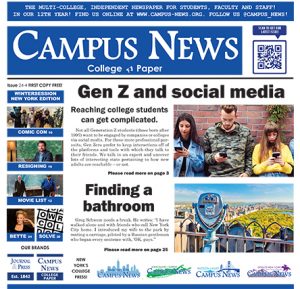By Darren Johnson and Felicia Reich
Campus News
It is well documented that social media has changed the way we relate to one another, our interests, work, and school. For the younger generations, particularly those who were born after 1997, the Internet and the rise of social media have been a presence in their lives for as long as they can remember. Talent development company Tallo conducted a study looking into the impact social media has had on Generation Z, particularly their education. For those that are now in college or just entering the workforce, what is the best way for companies and colleges to contact them? We interviewed Tallo CEO Casey Welch via Zoom for this piece.
As a population, this digitally native generation has different skills and needs than their previous generations. Welch explained: “If you think about the different work forces, nobody would say a Baby Boomer is that same as a Millennial, so why do we treat Millennials or Gen Z the same as we treat Millennials?” Welch said.

Tallo’s research concludes that this digitally native group, born after 1997, sees social media as a detriment to their education, not an aid. According to the study, 82% of Gen Zers believe that social media has proven to be a distraction to them while doing schoolwork.
“We’re understanding that social media is taking students away from their schoolwork, particularly in some environments. Some of the students across the country still aren’t in a classroom, so it’s even easier to get distracted,” described Welch.
Tallo’s study also breaks the Gen Z population down into segments. For female respondents, 3 out of 4 indicate that social media has caused them to compare themselves to peers, while this same statement is true only for 56% of male respondents.
Despite the drawbacks, social media serves as a resource to these students, with 71% having said they have learned a new study habit from social media.
In addition to helping students adopt new skills, social media can expand students’ interests. It also allows students to connect with potential schools or employers. According to the study, nearly half of respondents said that social media has influenced what they want to do as a future career. However, for companies or colleges who might want to recruit from this generation, it is clear that Gen Zers need to be engaged in different ways.
In a study Tallo conducted back in August, they found that not all students want to be engaged by companies or colleges via social media. For these more professional pursuits, Gen Zers prefer to keep interactions off of the platforms and tools with which they talk to their friends. To this demographic, texts and social media are too personal for such communication, with 71% of students in the study indicating they would rather be contacted by colleges via email.
Another way to communicate with Gen Z, Welch said, is to create genuine connection through outreach early and often. “Companies only reach out when the opportunity is available. A lot of times, students’ decisions are already made up. What we’re seeing a lot from this generation is there’s a thirst to learn. Before they’re willing to commit to a company or a college for a longer amount of time… show an interest, and make a connection before that opportunity exists.”
In terms of knowing what to say, “Make sure you get the right message. Sometimes you get the mechanism right, such as email, text, social media, but you turn them off with what you’re saying or what you’re showing.”
How companies and colleges speak to students is just as important as what they say. “If you fumble it at the front end, which is just getting them interested or speaking to them in the right way, you turn them off even though there’s that ideal opportunity behind that [generational] door.”
When asked how a school can better their social media presence to appeal to their current students, Welch responded: “Ask those questions. Take a segment and periodically understand what’s turning them off, what they’re excited about, what they want more of, what are they missing and what is lacking there.” According to Welch, doing so does not take a large amount of effort or time.
Once this information has been collected, segmentation plays an important role in how this data is interpreted and applied. “Look at those insights not as a population as a whole… Whether you’re talking about diversity in terms of gender, ethnicity, or geography, look at that data sliced individually.” According to Welch, not only does this microtargeting make consumers feel appreciated, but it brings any problems to the attention of the decision makers who can do something about it.
While students do not want schools and employers reaching out to them directly through social media, 59% of students in Tallo’s study said that they follow prospective colleges and universities on Instagram. Considering this fact, companies and colleges still need to maintain a strong social media presence for their recruitment and employment efforts.
There is no one-size-fits-all approach to communicating with Gen Z, Welch concluded. However, trust is key to getting someone from this generation engaged, with some 93% of them saying that they would be more likely to apply to your college if you built a relationship with them while they were in the 9th or 10th grade.








Facebook Comments